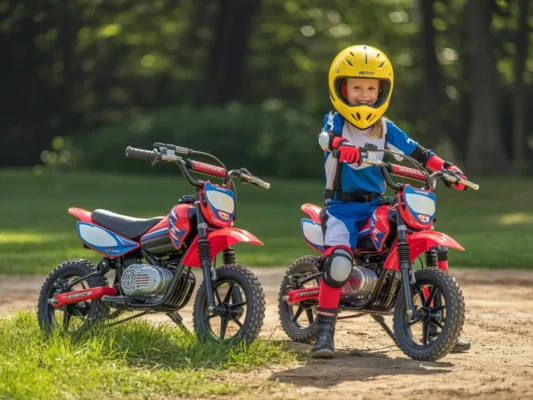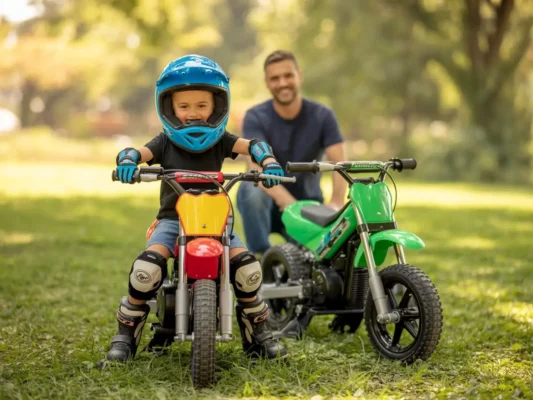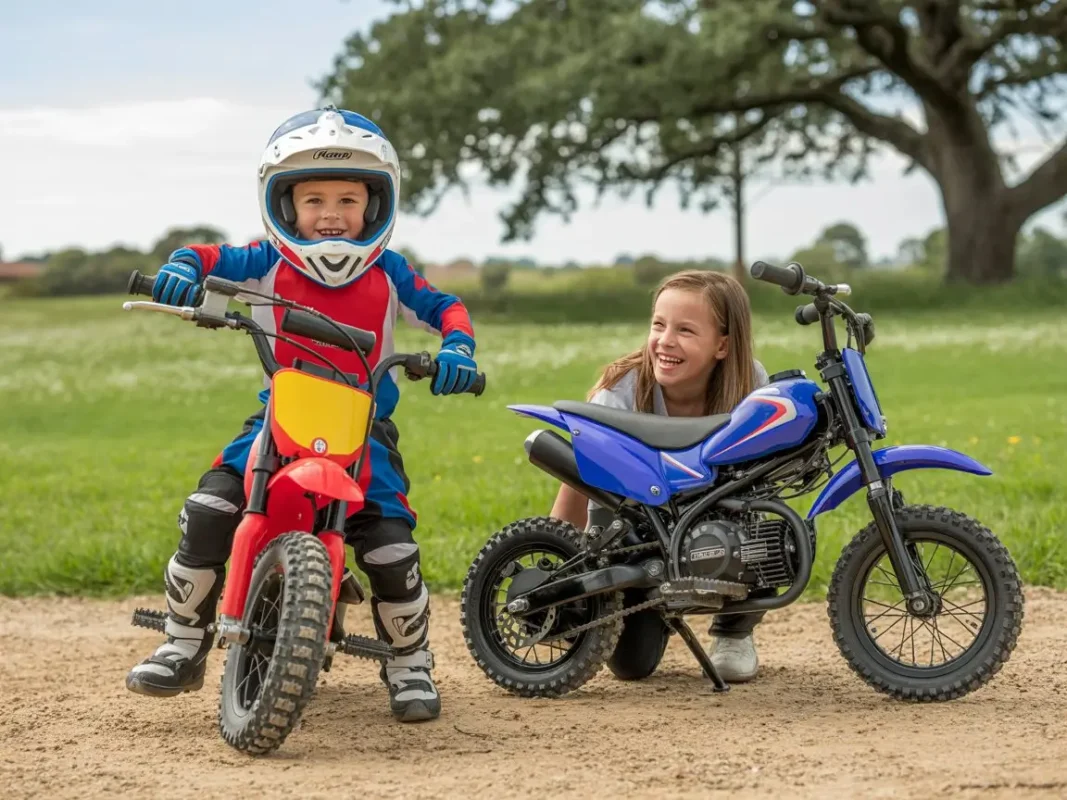Kids Mini Dirt Bike: The Complete Buyer's Guide for Parents
Choosing your child's first kids mini dirt bike is exciting but overwhelming. Gas or electric? Dirt bike or BMX? Should you spend $300 or $1,000? This guide cuts through the noise and helps you make the right choice for your family.
What Age Should a Kid Start Riding a Mini Dirt Bike?
Most kids can start riding between ages 3-5 on electric models. Gas-powered bikes typically suit kids ages 4-14, depending on the model. However, age isn't everything. Your child's size, coordination, and maturity matter more than the number on their birthday cake.
For toddlers (3-4 years), stick with low-powered electric bikes that max out around 10 mph. Kids aged 5-7 handle 40-50cc gas bikes or mid-range electric models well. Riders 8 and up can manage more powerful 70-110cc bikes if they've built foundational skills.
The Big Choice: Gas vs. Electric Dirt Bikes for Kids
This decision shapes everything else. Both types have loyal fans, and neither is “wrong.” What matters is matching the bike to your situation.
The Thrill of Gas (FRP GMB100, JOYSTAR Models)
Gas bikes deliver authentic dirt bike experience. They roar to life, require clutch control on some models, and teach mechanical responsibility. These bikes typically reach speeds of 15-20 mph, giving older kids room to grow their skills.
Pros: More power, authentic riding experience, longer runtime (1-2 hours), teaches maintenance skills, better resale value.
Cons: Requires oil/gas mixing, louder operation, produces emissions, needs regular maintenance, higher initial cost ($400-$800+).
Popular models like the FRP GMB100 and JOYSTAR bikes offer solid entry points for gas-powered riding.
The Ease of Electric (Burromax TT250, Razor MX650)
Electric bikes changed the game for young riders. They start with a button press, run whisper-quiet, and need almost zero maintenance. Modern electric dirt bikes can reach speeds up to 17 mph, plenty fast for learning.
Pros: Zero emissions, quiet operation (neighbor-friendly), instant torque, minimal maintenance, safer for beginners, typically cheaper ($200-$600).
Cons: Limited run-time (30-60 minutes), requires charging (4-12 hours), batteries lose capacity over time, can be heavier for small kids.
The Burromax TT250 stands out for durability, while the Razor MX650 Dirt Rocket offers a 650-watt motor for more experienced riders.
Understanding Bike Types: Dirt Bikes vs. BMX
Many parents confuse these categories. They're completely different animals built for different purposes.
Mini Dirt Bikes: For the Off-Road Adventurer
Dirt bikes feature knobby tires, suspension systems, and rugged frames built for trails, jumps, and rough terrain. They sit taller with more ground clearance and handle mud, rocks, and uneven surfaces.
Best for: Kids who want to ride on trails, dirt tracks, or off-road areas. Requires dedicated riding space.
Kids BMX Bikes: For Park & Pavement Performance
BMX bikes are lightweight, low to the ground, and designed for tricks, jumps, and speed on smooth surfaces. They lack suspension but excel at skate parks, driveways, and neighborhood riding.
Best for: Kids who want to ride around the neighborhood, do tricks, or hit the local skate park. No special riding area needed.
What's the Difference Between Electric and Gas Dirt Bikes for Kids?

Beyond the obvious power source, these bikes differ in philosophy. Gas bikes teach mechanical skills—your kid learns about fuel, maintenance, and engine care. Electric bikes prioritize ease of use, letting kids focus purely on riding technique.
Gas bikes demand parental involvement. You'll help with oil mixing, air filter cleaning, and spark plug checks. Electric bikes mostly need charging and occasional tire pressure checks. Budget for ongoing gas and oil costs versus eventual battery replacement ($100-$300).
Think about your living situation too. Electric bikes work anywhere. Gas bikes need space away from neighbors who might complain about noise.
Critical Buying Considerations
| Bike Type | Best For | Power Source | Avg. Price | Maintenance Level | Ideal Terrain |
|---|---|---|---|---|---|
| Gas Dirt Bikes | Kids 7+ with riding space | 2-stroke/4-stroke engine | $400-$1,200 | High (weekly checks) | Trails, tracks, open land |
| Electric Dirt Bikes | Beginners, urban families | Rechargeable battery | $200-$800 | Low (monthly checks) | Yards, parks, light trails |
| BMX Bikes | Trick riders, casual use | Pedal power | $150-$500 | Minimal | Pavement, skate parks |
How Much Should I Spend on a Kids Dirt Bike?
Start with $300-$600 for your child's first bike. Spending more doesn't guarantee they'll love riding. Once they prove commitment after 6-12 months, upgrade to a $600-$1,000 model with better components.
Avoid ultra-cheap bikes under $200. They break quickly, create safety issues, and frustrate kids. However, spending $1,500+ on a beginner bike wastes money. Kids outgrow bikes fast or lose interest.
Factor in these hidden costs:
- Safety gear: $150-$300 (helmet, gloves, boots, pads)
- Maintenance supplies: $50-$100 yearly
- Gas/oil or electricity: $10-$30 monthly
- Potential repairs: $100-$300 yearly
Top Picks & Recommendations
Best Gas-Powered Mini Dirt Bike: FRP GMB100
The GMB100 hits the sweet spot for gas bikes. Its 50cc 2-stroke engine provides enough power without overwhelming beginners. The bike includes quality suspension, disc brakes, and a sturdy frame that handles crashes. Worth the $500-$700 investment if you're committed to gas power.
Best Electric Dirt Bike for Beginners: Burromax TT250
Nothing beats the TT250 for electric beginners. Parents love the parent-controlled speed limiter. Kids love the responsive throttle and comfortable seat. The 250-watt motor balances power and safety perfectly. Budget around $300-$400.
Best Value BMX Bike: Cubsala / Maggie Kids Bike
For kids who want pedal power, these BMX brands deliver solid builds without premium prices. They're tough enough for learning tricks but won't break the bank when crashed. Expect $200-$350 for quality models.
Best for Young Riders (Ages 5-7): JOYSTAR Pluto
The Pluto series nails sizing for smaller riders. Lower seat height and lighter weight make it manageable for kids as young as 5. The balance bike approach builds confidence before adding power. Check JOYSTAR's lineup for current models around $250-$450.
Safety First: Essential Gear & Tips
Even for bikes with a 15-mile range, gear must be comfortable for long rides. Don't cheap out here—quality safety equipment prevents serious injuries.
Non-Negotiable Gear:
- DOT-approved helmet (replace after any crash)
- Riding boots (ankle protection crucial)
- Gloves (grip and hand protection)
- Goggles (debris protection)
- Long sleeves and pants minimum
Highly Recommended:
- Chest protector
- Knee/elbow pads
- Neck brace for aggressive riders
Most dirt bike boots help prevent and stabilize minor ankle sprains without additional bracing. Budget $150-$300 for complete safety gear initially.
Essential Safety Rules:
- Always supervise young riders
- Start in controlled, open areas
- Teach emergency stops before speed
- Set clear boundaries about where they can ride
- Make them earn riding privileges through responsibility
According to Waynesville Cycle Center's safety guide, proper supervision and age-appropriate vehicle selection significantly reduce injury risks.
What Size Dirt Bike Does My Child Need?
Forget engine size initially. Focus on whether your child can:
- Touch the ground with both feet while seated
- Reach and operate the brakes comfortably
- Handle the bike's weight when stationary
- See clearly over the handlebars
Weight matters more than height. A tall, thin 6-year-old might struggle with a bike a shorter, stocky 8-year-old handles easily. Select gear that supports riders up to 132 pounds for growing kids.
Test ride if possible. Your child should mount and dismount without help and maneuver the bike while off.
Do Kids Need Special Maintenance for Their Dirt Bikes?

Yes, but how much depends on the type. Gas bikes need weekly attention during riding season. Check the air filter, chain tension, tire pressure, and brake function. Change oil every 5-10 hours of riding. Clean or replace air filters monthly.
Electric bikes require far less. Charge properly (don't overcharge), keep tires inflated, and tighten bolts monthly. That's mostly it until the battery shows age after 2-3 years.
Teach your kid basic maintenance. It builds mechanical understanding and responsibility. Start simple—checking tire pressure or cleaning the chain—then progress to more complex tasks.
Should I Buy New or Used?
Used makes sense for first bikes if you know what to check. Kids outgrow bikes quickly, so lightly-used options save money. Inspect for:
- Frame cracks or serious damage
- Brake function
- Tire condition
- Engine compression (gas bikes)
- Battery health (electric bikes)
New bikes include warranties and known history. They cost more upfront but eliminate uncertainty. For electric bikes especially, battery age matters enormously. A 3-year-old electric bike might need a $200 battery replacement soon.
Middle ground: Buy from reputable specialty shops that refurbish used bikes. You get better prices than new with some warranty protection.
FAQ: Kids Mini Dirt Bike Questions Answered
Can a 4-year-old ride a dirt bike?
Yes, but only specific models designed for that age. Stick with electric bikes under 250 watts that max out around 8-10 mph. Always supervise closely and ensure proper safety gear.
How long do electric dirt bike batteries last?
Battery runtime ranges from 30-60 minutes per charge. Battery lifespan before replacement runs 2-4 years with proper care. Avoid depleting completely and don't overcharge.
Are gas dirt bikes hard to maintain?
They require more attention than electric models but aren't complicated. Budget 30-60 minutes weekly for basic checks and cleaning. Most parents handle maintenance without mechanic skills.
What's safer: gas or electric dirt bikes?
Both are equally safe with proper supervision and gear. Electric bikes offer better speed control for absolute beginners. Gas bikes teach throttle moderation. Safety depends more on supervision, gear, and riding environment than power source.
Can dirt bikes ride on streets?
Most mini dirt bikes aren't street-legal. They lack lights, mirrors, and DOT approval. Ride on private property, designated trails, or off-road parks only. Check local regulations.
How fast do 50cc dirt bikes go?
Most 50cc bikes reach 15-25 mph depending on rider weight and terrain. That's fast enough to learn skills but manageable for kids 6-10 years old.
Do I need insurance for a kids dirt bike?
Homeowners insurance might cover accidents on your property. Check your policy. Off-property riding might need additional coverage. Most people ride uninsured on private land, accepting the risk.
Conclusion: Making Your Choice
The best kids mini dirt bike depends on your child's age, personality, and where they'll ride. Beginners and younger kids (3-7 years) typically succeed with electric models that prioritize ease of use. Older kids (8+) ready for authentic riding experience thrive on gas-powered bikes.
Don't rush the decision. Consider starting with a quality electric bike to gauge interest, then upgrade to gas if they show commitment. Remember that safety gear matters more than the bike itself—never compromise on protective equipment.
Ready to get your child riding? Start by reviewing our detailed recommendations above. Match their age and skill level to the appropriate bike type, invest in proper safety gear, and commit to supervision. Your kid's dirt bike journey starts with one informed decision.

